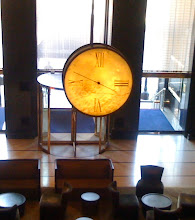In reality, The Andy Griffith Show didn’t transcend the deep divides of its time. It merely ignored them. “Local control” of Mayberry saw to it that this southern town would remain lily-white for all eight years of its fictive existence rather than submit to any civil-rights laws that would require the federal government’s “top-down management” to enforce. Nor was television always so simple back then. Just seven months before The Andy Griffith Show’s 1960 debut on CBS, the same network broadcast an episode of The Twilight Zone, “The Monsters Are Due on Maple Street," in which the placid all-American denizens of an (all-white) suburban enclave turn into a bloodthirsty mob hunting down any aliens in human camouflage that might have infiltrated the neighborhood. As the show’s creator and narrator, Rod Serling, makes clear in his parable’s concluding homily (“Prejudices can kill …”), the hovering aliens who threatened to drive Americans to civil unrest and self-destruction at the dawn of the Kennedy era were not necessarily from outer space.
The wave of nostalgia for Andy Griffith’s Mayberry and for the vanished halcyon America it supposedly enshrined says more about the frazzled state of America in 2012 and our congenital historical amnesia than it does about the reality of America in 1960. The eulogists’ sentimental juxtapositions of then and now were foreordained. If there’s one battle cry that unites our divided populace, it’s that the country has gone to hell and that almost any modern era, with the possible exception of the Great Depression, is superior in civic grace, selfless patriotism, and can-do capitalistic spunk to our present nadir. For nearly four years now—since the crash of ’08 and the accompanying ascent of Barack Obama—America has been in full decline panic. Books by public intellectuals, pundits, and politicians heralding our imminent collapse have been one of the few reliable growth industries in hard times.
The outpouring traverses the political spectrum, from the apocalyptic hard right (Patrick Buchanan’s Suicide of a Superpower, Mark Levin’s Ameritopia) to the conservative Establishment (Charles Murray’s Coming Apart: The State of White America, 1960–2010) to the centrist Washington Establishment (Norman Ornstein and Thomas Mann’s It’s Even Worse Than It Looks) to centrist liberalism (Thomas Friedman and Michael Mandelbaum’s That Used to Be Us) to the classically progressive (Timothy Noah’s The Great Divergence). Depending on the political coloring of the authors, the books have different villains: the tea party, coddled Wall Street plutocrats, coddled welfare-state entitlement junkies, the yapping and trivializing news media, broken schools, a polarized and broken Congress, a politicized Supreme Court, a socialist president. And China Über Alles (with an occasional cameo by India). The books’ pet issues also vary, from the collapse of the family to the debasement of cultural values, the demise of political compromise, the extinction of the “vital center,” the president’s feckless “leading from behind” in foreign affairs, the rise of income inequality, the ballooning of the national debt, and unchecked federal spending. But the bottom line is nothing if not consistent, and is most concisely summed up in a tirade delivered to a hall of college students by Aaron Sorkin’s alter ego, a television anchor played by Jeff Daniels, in the HBO series The Newsroom: “When you ask what makes us the greatest country in the world, I don’t know what the fuck you’re talking about. Yosemite?”
These declinist authors have in common a paucity of plausible or practical solutions to address the laundry lists of imperatives that America must deal with urgently if it is to save itself from perdition or extinction. But their most revealing shared trait, whatever their individual politics or panaceas, is an authorial demographic—they are all white men of a certain age. It’s not happenstance that the Indian-born Fareed Zakaria, who shares some of the declinists’ complaints, conspicuously stands apart from them by defining his subject, in The Post-American World, as not “the decline of America” but “the rise of everyone else.”
…
The severity of the economic crisis notwithstanding, the underpinnings of our discontent are almost uncannily reminiscent of those that marked all our other modern waves of American declinism. Witness an essay by the political scientist Samuel P. Huntington written in 1988 for the journal Foreign Affairs on the question “The U.S.—Decline or Renewal?” The proximate crisis of declinist panic then was the October 1987 stock-market crash and the economic rise of Japan. Surveying that era’s own blizzard of declinist lit, led by the historian Paul Kennedy’s best-selling The Rise and Fall of the Great Powers, Huntington compiled an inventory of woes that can be found in most of the 2012 sequels: America was losing its competitive edge, piling up trade and fiscal deficits, declining in growth, and falling behind in education, research, and development. And, as Huntington pointed out, the declinist panic of the late eighties was the fifth in a mere three decades—following the “Sputnik moment” of 1957–58, the economic rise of Europe and Japan in the late sixties, the opec oil shock of 1973, and the cornucopia of woes of the later seventies (Watergate, defeat in Vietnam, the Iranian hostage crisis). Since then, the spin-and-dry cycles of morning and mourning in America have repeated themselves like clockwork, with scant variation from the Huntington template. Hardly had Bill Clinton celebrated peace and a booming economy in his 2000 State of the Union valedictory than the tech bubble burst and the market crashed once more, soon to be followed by 9/11 and the long “Why do they hate us?” funk of the American soul.
Can you match each declinist book with its diagnosis of America’s downfall?
Play here.
- Posted using BlogPress from my iPad

No comments:
Post a Comment